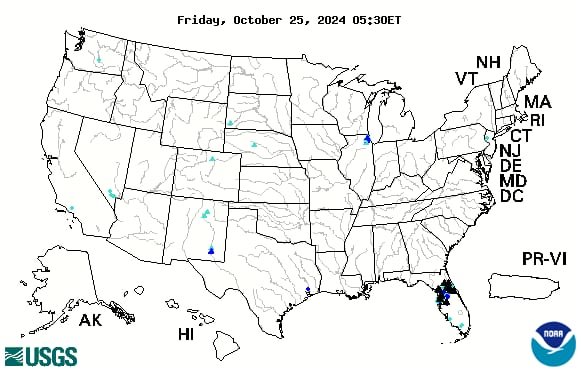
The Current Rain Situation in the U.S.
The rain patterns across the United States this year have showcased the country’s vast climatic diversity. From droughts plaguing some areas to others experiencing relentless downpours, understanding the current rain situation in the U.S. reveals the critical role geography plays in weather patterns, water availability, and even agricultural productivity. Here’s a closer look at the current rainfall situation across different regions, examining the causes, impacts, and forecasts for the near future.
1. The Southwest: Persistent Drought and Water Scarcity
- Current Situation: Many southwestern states, including Arizona, Nevada, and parts of California, have seen below-average rainfall this year. Long-standing drought conditions persist, exacerbating water scarcity and stressing both communities and ecosystems.
- Impacts: The scarcity has heavily impacted agricultural outputs and forced local governments to implement water-saving measures. Reservoirs, such as Lake Mead, remain at critically low levels, prompting efforts to reduce water usage among both residents and businesses.
- Cause: The ongoing drought is largely attributed to a combination of climate change and natural weather patterns, such as La Niña, which brings drier-than-usual conditions to the Southwest.
- Outlook: Forecasters predict minimal improvement in the coming months, with many areas expecting continued dry conditions. Long-term projections suggest that drought will likely become more frequent in this region, requiring adaptive water management strategies.
2. The Midwest: A Mix of Floods and Dry Spells
- Current Situation: Rainfall in the Midwest has been variable, with some areas experiencing heavy downpours while others face rainfall deficits. The upper Midwest has seen more rainfall, while portions of the lower Midwest are experiencing drier-than-average conditions.
- Impacts: The fluctuation between heavy rainfall and dry spells has created challenges for agriculture, particularly corn and soybean production, which depends on consistent rainfall. Additionally, the increased rainfall in some areas has caused localized flooding, impacting infrastructure and homes.
- Cause: This variability is partly due to shifts in jet stream patterns, which direct storms and rainfall across the region. In recent years, these patterns have become more unpredictable, often leading to extreme weather events.
- Outlook: The forecast suggests that this pattern of variability will continue, with more frequent extreme weather events anticipated. As climate change influences jet stream behavior, the Midwest may need to prepare for more inconsistent rainfall patterns.
3. The Northeast: Abundant Rainfall and Flood Risks
- Current Situation: The Northeast has received above-average rainfall this year, leading to occasional flash floods in states like New York, Pennsylvania, and New Jersey. Unlike the drought-stricken West, this region is facing water abundance, with rainfall often exceeding seasonal norms.
- Impacts: The excess rain has caused disruptions in urban and rural areas, leading to flooded streets, damaged infrastructure, and temporary displacement of residents. The additional moisture has also fostered ideal conditions for pests and plant diseases, affecting local agriculture.
- Cause: Warmer-than-average Atlantic sea surface temperatures are fueling a more active storm season in the Northeast. These warmer waters help generate and sustain rain-heavy storms, which can result in significant precipitation and flooding.
- Outlook: The Northeast is expected to remain wetter than usual, particularly as tropical storms continue to develop. Residents may need to stay vigilant and prepare for potential flood events as hurricane season intensifies.
4. The Southeast: Tropical Storms and Seasonal Rains
- Current Situation: The Southeast is deep in the hurricane season, with a series of storms and tropical depressions bringing sporadic heavy rainfall to the region. States like Florida, Georgia, and the Carolinas have already seen substantial rainfall, with the threat of more to come.
- Impacts: Flooding, power outages, and coastal erosion are common issues, particularly along the Gulf Coast and in low-lying areas. Agricultural lands, especially cotton and peanut fields, are vulnerable to prolonged wet conditions, which can impact yield and quality.
- Cause: Warm ocean temperatures have increased the frequency and intensity of storms, which can lead to extended rainy periods in the Southeast. The tropical Atlantic is especially active this year, a phenomenon partly tied to rising global temperatures.
- Outlook: More rainfall is likely in the near term, especially if additional tropical storms make landfall. Climate models suggest the region may experience longer, more intense rainy seasons in the coming years.

Final Thoughts: The Role of Climate Change in Rainfall Patterns
The current rainfall situation across the U.S. highlights the complex relationship between climate patterns and precipitation. Regions like the Southwest and Midwest are feeling the strain of inconsistent or lacking rainfall, while the Northeast and Southeast face the challenges of an excess. As climate change continues to alter weather patterns, more intense droughts, rainstorms, and hurricanes are expected to shape the U.S. rain situation in the years to come. For residents, local governments, and industries, the key to resilience will be adapting to these shifts and implementing sustainable water and land management practices.